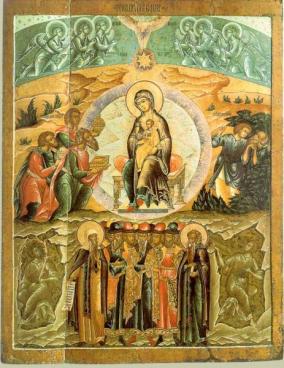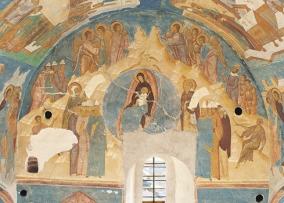The meeting on the second day after the Nativity of Christ, dedicated to the Cathedral of the Mother of God, was held in the Virtual Branch of the Russian Museum at the Church of the New Martyrs and Confessors of Russian Orthodox Church. During the festive meal, the assembled parishioners listened to the abbot of the temple Archimandrite Gurii (Danilov), who proposed an article for discussion on what Christmas is from the point of view of a person, a poet and God? "The Gospel of John contains a brief outline of God's plan for Christmas and generally about the meaning of the Incarnation. It's amazing how it was possible to slip past what God wanted to say and exchange for what they themselves invented: bonfire, wind, dry clothes, kolivo, Christmas trees, first star and Brodsky? "- says priest Konstantin Kamyshanov.
The second day of the feast of the Nativity of Christ is dedicated to the gloification and thanksgiving of the Theotokos, this day is called the Cathedral of the Mother of God.
The frescoes of Dionysius from the Cathedral of the Nativity of the Virgin of the Ferapontov Monastery were shown to the participants of the Virtual Russian Museum, conveying in the colors the Gospel of the Nativity of Christ. The paintings are distinguished by the subtlest harmonic beginning, the clarity of color and images, the relaxed rhythm. Ferapontov frescos give the most complete and multifaceted idea of the style of Dionysius, which develops the traditions of the masters of the circle of pr. Andrei Rublev in the direction of greater aesthetization and idealization of forms: figures at the expense of the generalization of interpretation, as it were, lose their bodily nature, being in an immense and ethereal world, permeated with divine radiance.
There is in the center of the amazingly symmetrical, triangular composition in the Feparontian cathedral - the Virgin and Child sitting on her bed. A gently purple bed is depicted vertically, so it turns out to be similar to the sphere that symbolizes the glory of the Mother of God. But there is also this "glory" itself - in the form of a large dark-blue circle embracing the bed. Its color corresponds to the color of the sky at the top of the composition. It is interesting that the skies here "round off" in accordance with the shape of the arch (another evidence of the exceptional spiritual and artistic flair of the great icon painter is the inclusion of painting in architecture, and not the fight against it).The Infant Christ is the center of the plot. His white shirt seems to be a source of light, which lightly flares up then on the surrounding slides, the clothes of people and angels. And, finally, the light concentrates in white unfolded sheets in the hands of the two saints, who are closest to the Mother of God and the Infant. To the left, in a white headdress, St. John Damascene, an outstanding church poet, the author of many hymns in honor of the Mother of the God. And to the right - Saint Kosma Mayumsky, the author of this chant.
The icon "Cathedral of the Mother of God" from the collection of the Russian Museum represents Yaroslavl icon-painting school. Comes from the church of the Fedorovskaya Mother of God in Yaroslavl (1680-1690-e). The composition of the icon is based on the text of the Christmas stichera, a thank-you song that is part of the evening services on the eve of the Feast of the Cathedral of the Mother of God on January 8: "What did Ty bring, Christ, as you were on earth, as a man for us? In every way thanks to You from the former creatures, Thanksgiving brings You: angels singing, stars heaven, wolves gifts, pastoral miracle, earth den, desert nursery, we are the Mother and the Virgin. " The content of the stichera- thanksgiving to Christ, brought by all God's creatures, - determined the iconographic scheme of illustrations for the hymn that was formed in the Balkans at the end of the 13th - the beginning of the 14th century.
The sense center of the composition is the image of the Mother of God sitting on the throne, with the infant Christ in her arms; Surrounded by angels, magi and shepherds - witnesses to the miraculous appearance of Christ.
The Mother of God brought by the human race singing in the hymn as a special gift to God, is glorified in the composition of the "Cathedral" on a par with her Divine Son. This idea is emphasized by the inclusion in the scene of the image of the alleged author of the stichera and the creator of the Virgin canons - St. John of Damascus, in the unfolded scroll of which the text of the chanting of the 8th Sunday's voice of Octoechus is read "O You are rejoicing over the joyful ...". An expressive feature of the Yaroslavl monument is the image along with John of Damascus of the Monk John, hegumen of the Sinai Mountain, the compiler of the famous "Ladder" - works on the paths of spiritual ascent. This detail of the iconography is not accidental. The image of "Ladder" is one of the stable epithets of the Mother of God, glorified in Akathistos as "the heavenly ladder, Even God's Feet" (Ikos 2). In the tropare of the 4th song of the Canon of the Monk Joseph the Pesnopis (9th century), it is sung about her: "Rejoice in the ladder, from the land of all, exalted by grace."
Noteworthy are the solemn "wedding" clothes of representatives of the human race, who prepared themselves for participation in the feast of Wisdom, which came to renew the world. [Iii]
Usually in the compositions "Cathedral of the Virgin"there are Solemn Christmas service at the bottom of the image : chorus of singers, hymnographers, priests, monks; Patriarchs and kings may also be depicted. This group, on the one hand, embodies the whole human race, which, according to the stichera, brings the Mother of Virgin to Christ. Above, above the slides, there are angels and wondering shepherds.
To the right and to the left of the foot of the throne there are on the icon two peculiar figures: half-naked women with disheveled hair. These personifications are images that represent the Desert and the Earth. Desert, dressed in red, brings a manger to Christ, and the Earth, clothed in a green cloak, stretches out a den with one hand, and in the other holds a branch.
The most difficult figure to interpret is the dancing young man. There is an opinion that this is a young shepherd, marveling (wondering) the miracle of Christmas. Struck, he covers his face with his hand, which resembles the shepherd of the icon depicted in the back corner - the one who sees the star, also covers his eyes. The young man's clothing is a short chiton that corresponds to the tradition of depicting shepherds. It is easier to define the image of another young man with a book in his hands. Some researchers see him as a Roman Slave; Others, pointing out the absence of a halo, the reduced size of the figure and other details, believe that this is some kind of collective image of a hymnographer or reader.
In the monuments of the 16th-17th centuries the composition greatly expanded, it includes the personifications of the sea and the winds that bring the child, in the expression of the icon-painting script, obedience and obedience. The image of the worshipers becomes more and more multi-figured. [Iv]
It is assumed that the whole group as a whole can personify various forms of glorification of the Mother of God, which is performed by all mankind (therefore characters of different ages and peoples are depicted). The three central figures were treated like a chorus of singers, like deacons, like the Godfathers David, Joseph and Jacob. They were defined as "shepherds in the concrete and figurative meaning of this word" [v], meaning by this also the wandering performers of spiritual verses dedicated to biblical events.
[I] http://www.afonru.ru/news/2014_12_29/8/
[Ii] http://www.pravenc.ru/text/178357.html
[Iii] Sophia the Wisdom of God. Exhibition of Russian icon painting of the XIII-XIX centuries from the collections of Russian museums: [Catalog]. - Moscow: Radunitsa, 2000. - Cat. No. 59, pp 178-179
[Iv] http://www.pravmir.ru/ikona-sobor-bogomateri-i-ee-zagadki
Reformatskaya MA Pskov iconography XIII - early XV centuries (To clarify the concept of "local school"): Dis. M., 1979. P. 117, 118
The subsidiary of the Russian virtual museum in the city of Cheboksary
tags cloud
- #opening_of_a_branch
- #lecture
- #exhibition
- #virtual_exhibition
- #virtual_tour
- #online_exhibition
- #мультимедийная_выставка
- #poster_exhibition
- #online_event
- #masterclass
- #contest
- #занятие
- #festival
- #video_conference
- #round_table
- #conference
- #seminar
- #дошкольники
- #школьники
- #студенты
- #семья
- #серебряный_возраст
- #инклюзия
- #multimedia
- #Business_meeting_of_virtual_brances
- #The_Multimedia_Centre
- #Drammatika
- #деньмузеевВФРМ
- #ночьмузеевВФРМ
- #RussianMuseum130
- #RussianMuseum125
- #RussianMuseum120
- #RMcatalogues
- #Библионочь
- #книгиГРМ2019
- #игрыРМ
- #фильмыРМ
- #ночьискусствВФРМ
- #Artefact
- #100years_restorationRM
- #Peter_I_350
- #Antarctica200
- #folk_art
- #profession_restorer
- #RM_anniversary
- #SPb_anniversary
- #80летПобеды

